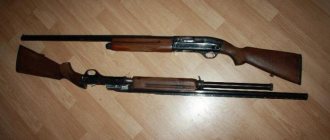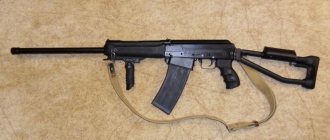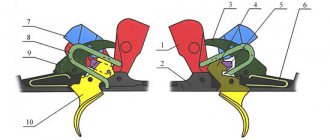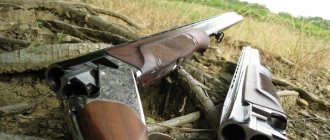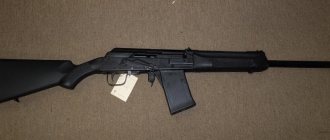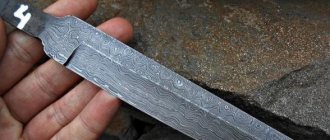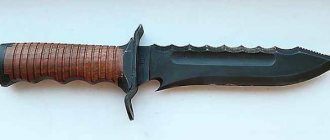- August 29, 2018
- Weapons and ammunition
- Michael
Probably every one of our compatriots who is fond of hunting has heard about the MTs 21-12 semi-automatic shotgun. It is one of the most common ones developed and released in our country. The weapon has a number of important advantages that you should know about. But it also has certain disadvantages, knowing which the hunter will be able to decide: to give preference to this semi-automatic device or to look for another option.
History of weapons
Let's start with the fact that it was the MTs2112 that became the first Soviet semi-automatic smoothbore shotgun. Although the designers tried to create it as original as possible, as a result of long work they came to the conclusion that it had features inherent in its foreign counterparts. Which, however, is not surprising - brought almost to perfection over years of careful refinement, it simply could not help but follow the paths already developed earlier. For example, the automation circuit turned out to be similar to the Browning, and the easily removable receiver cover was very reminiscent of Italian semi-automatic devices from Breda Antares.
MTs 21-12 was created at the Tula Arms Plant under the leadership of V. A. Nikolaev in 1956-1958. Several trial copies were produced, but certain shortcomings were identified in them. Then it was decided to postpone the start of mass production until they were completely eliminated. Therefore, the first samples rolled off the assembly line only in 1965.
At first, the weapon, which received the nickname “Soviet Browning” among hunters, received mostly negative reviews - the reason was poor compatibility with folder cartridges, which were widespread at that time. But gradually, as plastic analogues appeared and spread, the gun began to gain more and more supporters.
However, it was appreciated not only in our country. So, in 1965, the gun received a high award - a gold medal at the Leipzig Fair, which is a serious recognition of quality.
As a result, both in Soviet times and later, already in the Russian Federation, more than 300 thousand guns were produced - a very good figure.
Semi-automatic MTs 21-12: originally from the USSR
Photo by Semin Mikhail.
I remember how in the early eighties I stood at the counter of a hunting store on Neglinka and admired the MTs 21-12 - there were several of them, in different designs.
Then this only serial semi-automatic machine, produced in the USSR and gaining well-deserved fame, seemed to me the ultimate dream.
It is difficult to find a hunter who has not held in his hands or at least encountered this unusual and original gun in his own way while hunting.
Developed at TsKIB, MC 21-12 was designed by designer V.A. Nikolaev. The weapon’s passport stated: “The gun is a self-loading single-barreled weapon for commercial and amateur hunting.”
From 1958 to 1964, the model was manufactured only at JSC TsKIB and, interestingly, until 1965 it was produced in 16 and 20 calibers, albeit in very small series. The gun was recognized both in the USSR and abroad: at the Leipzig fair, held in 1965, the MTs 21 was awarded a gold medal.
Unfortunately, after 1965, weapons were no longer produced by TsKIB, but by TOZ, which led to the desire to reduce the cost of production and optimize some processes. It is from this period that stories are associated with guns that do not work out of the box and that the quality is not always good.
This statement mainly concerns items manufactured after the 90s, when the quality of manufactured weapons products dropped noticeably.
Read the material “Is it good to live with a pump-action weapon in Russia”
But no matter where the weapon was created, it always had excellent accuracy and sharpness of combat.
Actually, it was precisely because of this that the hunters of the USSR fell in love with it.
In addition, the diseases of MC 21-12 were not congenital, and the experience of using them in hunting and a large circulation contributed to the emergence of comprehensive instructions for eliminating shortcomings that arose during the manufacture of guns.
There are not many hunting rifles that use a long-stroke design. This scheme was proposed by D. Browning at the beginning of the last century and served hunters faithfully for more than a hundred years.
| MC 21 has become truly classic and can decorate the arsenal of a Russian hunter. Photo by Semin Mikhail. |
It was this that formed the basis of MC 21-12. The long stroke of the barrel is characterized by the fact that when fired under the influence of recoil, the barrel engaged with the bolt rolls back to its extreme position, after which the barrel with the bolt is disengaged and, under the influence of the return spring, moves forward to its original position, while the spent cartridge case is extracted, which pushes out the reflector located on the stem of the barrel.
If there are no cartridges in the magazine, the bolt remains on the slide stop; if there are cartridges, the bolt moves forward under the influence of a spring and fires the next cartridge from the tray.
The recoil of guns with a moving barrel is stretched out and is usually perceived as softer, but not all hunters like the feeling of the barrel moving.
Read the material “Hunting semi-automatic devices”
The appearance of the weapon is unusual: a relatively long frame, a massive fore-end, and a large overall length. The sighting bar looks peculiar, as it does not reach the box. But this phenomenon can be explained simply: when fired, the barrel goes almost 80 mm into the box, which is precisely why the retrieval on the rail is needed.
On the right side of the box there is a bolt stop button and a safety lever, which can be installed either on the right or on the left - as convenient for the shooter. On the left side of the box there is a cartridge cut-off switch that can be used to block the flow of cartridges from the magazine.
| An unusual and original solution with two ferrules on the sides of the brake. Photo by the author. |
This makes it possible to quickly change the cartridge in the chamber or turn the weapon into a single-shot one. When fired, the cartridge case will be ejected, and the bolt will remain on the slide stop.
You can simply throw the next cartridge onto the tray and press the delay button, the bolt will send the cartridge into the barrel, and the weapon is ready to fire.
When the cut-off switch is switched, the gun returns to normal operation. It should be noted that the Browning gun, the progenitor of the MC, also had a cut-off device, but it did not take root.
The stock with a semi-pistol grip turned out to be very convenient. In general, despite its size, the weapon turned out to be very useful.
In terms of control and operation, the MC 21-12 is convenient and comfortable, charging and discharging is not cumbersome, all manipulations are intuitive. But as for the internal structure, everything is more complicated here.
| A distinctive feature of shotguns with a long barrel stroke is the selected rib. Photo by Semin Mikhail. |
Like all domestic weapons from the times of the USSR, the MTs 21 can be disassembled without tools (we are, of course, talking about incomplete disassembly for maintenance, cleaning and lubrication).
So, to disassemble the gun, you need to unscrew the nut of the tubular magazine, after which the forend will be removed forward, but nothing should jump out anywhere.
It happens that the magazine spring comes out, but this indicates a malfunction of the plug. In many guns, like ours, the owner bends the edge of the magazine tube slightly to solve this problem once and for all.
It is not recommended to do this, because it makes disassembling the magazine difficult, and it must be disassembled, at least for cleaning and lubrication, especially if the gun is wet.
Read the material “Choosing a semi-automatic machine”
In addition, we will not be able to install a magazine extension, if, of course, such an idea arises. After removing the forend, holding the barrel, we pull back the bolt, while it disengages and releases the barrel, and we remove it from the magazine tube.
Many hunters end disassembly at this point, believing that further disassembly of the weapon is too difficult. In fact, this is a myth, and we will continue. The box cover is removed by moving forward (sometimes this requires significant force).
| Photo by the author. |
But then there are two options: either we remove the shutter, or we remove the base from the trigger. When disassembling, this order does not matter much, but during assembly, problems may arise. So, it is better to first remove the trigger unit.
To do this, we use some object to recess the opposite, protruding part of the safety flag and take it out; in this case, it is better to place the flag in an intermediate position between “fuse” and “fire”.
Next, we remove the block, and to remove it smoothly, we press the shutter stop button.
To remove the shutter, we find the stopper - a small part located at the bottom of the shutter body - and move the latter forward until it comes out of the box. Now we can say that the disassembly is complete.
| MC 21-12 has excellent combat and accuracy. Photo by Semin Mikhail. |
If the gun is very dirty or wet, you can remove the bolt return spring located in the stock and clean it. To do this, you need to remove the shock absorber by unscrewing two screws and unscrew the plug of the return spring tube.
Sometimes you have to disassemble the bolt itself, especially when thick lubricant gets into the firing pin cavity (in the cold this can play a cruel joke).
To disassemble the shutter, you need to press the stopper and slide the part at the bottom of the shutter; after removing it, the shutter is disassembled into two halves, which is more than enough for its maintenance. For cleaning and lubrication, it is better to use liquid oils, but not in abundance, as this leads to severe contamination.
Assembling the weapon is done in the reverse order, but it is recommended to install the bolt first, and only then the trigger. This is due to the shutter rods; It’s easier to get them into the spring tube when the trigger is not installed.
Read the material “Self-loading has nothing to do with it”
But in principle, a different order is also possible, and then the rods will have to be pryed off with something (a knife, screwdriver or paper clip will do the job).
The main thing when installing the trigger is to make sure that the feed tray is in the down position, and do not forget to press the shutter stop button, otherwise it will not be easy to insert the trigger.
The alert reader probably noticed that our gun has two crimp rings. This is such a modernization.
In a regular gun there is only one ring and it is installed behind the brass brake ring, and there are two options for installing it: beveled forward, which enhances braking, and beveled back, which reduces the compression force of the brake ring.
The fact is that the barrel ring, which is put on the magazine, has a cone, and the brake ring fits into it with its front part and always works. By turning the rear wheel over, we either add braking or not.
So the owner says that the second ring allows you to “turn off” the front braking and shoot lighter charges. I can’t say how correct this is, but the gun works flawlessly.
| Photo by the author |
There is a lot of talk about the reliability of the MC 21, but in reality there is one problem that accounts for approximately 99% of failures. We are talking about non-disengagement of the barrel and bolt in the rear position.
In most cases, this problem resolves itself with a small amount of shooting (only 200–250 shots are needed), but sometimes it is necessary to use your hands. The cause of this problem is the round wedge that locks the bolt.
Read the material “Self-loading with a hundred-year history”
Why it is round is difficult to explain. Perhaps this is a simplification of production, but there is an opinion that this is an attempt to circumvent Browning's patent.
The first version looks more plausible. As it turned out, it is much more difficult to properly fit a round wedge to a round hole than a square wedge to a square hole, and a poor fit leads to misalignment. Usually polishing this unit solves the painful problem.
The craftsmen working on the modification of the MTs 21 believe that any gun can be brought to perfect condition, after which it will faithfully serve its owner for many years.
As a truly cult thing, MC 21-12 evokes the delight of some and the curse of others.
It is inexpensive in thrift stores today and, it seems to me, deserves to be in a hunter’s arsenal.
Semyon Morozov October 5, 2022 at 12:40 pm
Specifications
Now let's briefly talk about the technical characteristics of MC 21-12. The gun, having a barrel length of 750 millimeters, provides excellent combat range - both with shot and grape cartridges, and with a bullet. The total length is 1285 millimeters - a rather serious indicator, due to which it is not very convenient for people of shorter than average height, as well as for teenagers. This should definitely be taken into account when purchasing a weapon.
The weight is 3.4 kilograms - not too much, thanks to which a strong man accustomed to long marches can use it both for clay pigeon shooting and driven hunting. Most analogues - semi-automatic 12 gauge - weigh about the same, with a difference of 100-200 grams in one direction or another.
Designed to fire 12/70 cartridges. It has a muzzle constriction of 1.0 - full choke, which additionally ensures high accuracy of combat with shot and buckshot at a long distance.
When loading, the first cartridge is immediately sent into the chamber. Four more are inserted into the under-barrel magazine. Thus, without additional charging, the hunter can fire five shots at a very fast pace, which allows shooting, for example, at a flock of ducks or geese, as well as quickly picking up wounded animals.
Existing modifications
Over the years of production, several weapon variants have been developed. They are not too different from each other - the characteristics of the MTs 2112 gun remain the same. But still, it will be useful to know about them for every shooting enthusiast who has decided to purchase this particular semi-automatic machine.
Thus, the name MC 21 was given to the very first model, several versions of which were released before the official start of production - from 1956 to 1964. Then they created guns for 12, 16 and 20 calibers to check which would be the most successful.
The MC 21-12 model, well known to hunters, became the second and went into serial production in 1965.
Subsequently it was slightly modified. The butt plate was supplemented with a rubber shock absorber, resulting in the appearance of the MTs 21-12R.
But the latest model has also been improved. This modification received not only a rubber shock absorber, but also replaceable muzzle attachments, allowing you to choose the appropriate model depending on the shooter’s goals and available ammunition. It was named MC 21-12MR
Interesting Facts
The MTs-21-12 model shotgun was presented to foreign buyers at the international fair in Leipzig in 1965. The weapon received positive reviews and, following the results of the fair, was awarded a gold medal.
After the collapse of the USSR, the MTs-21-12 gun was included in the list of standard weapons for various private security companies (used until 2006).
Currently, the weapon is the standard weapon for certain categories of employees of the Ministry of Forestry of the Russian Federation.
When firing a bullet designed by Polev from a working MTs-21-12 gun, it is capable of splitting up to five bricks at a distance of 100 meters.
Today, despite problems with the quality of the new MTs-21-12 shotguns and the emergence of a large number of Chinese-made competitors, the weapon remains in demand on the market. The reasons for its popularity are its unique operating pattern, maintainability and high accuracy of fire.
Soviet or Russian release?
Although today the MTs 21-12 gun, the characteristics of which are described above, has already been discontinued, a certain quantity was produced after the collapse of the USSR. Unfortunately, it is they, quite often falling into the hands of young hunters, that create the illusion of the extremely low quality of weapons in this series.
Yes, unfortunately, the gun, which received excellent reviews from experienced Soviet hunters, was practically destroyed due to poor quality manufacturing. First of all, the build quality suffered - because of this, the number of cartridge cases distortions during ejection increased. In addition, in order to increase the speed of weapon assembly, pre-chromed components began to be used. As a result, debuggers had to finish the details directly from chrome. The quality of heat treatment of components has decreased. Many owners began to complain about the poor quality of wood processing and burrs on metal. Of course, seeing such a weapon up close, the hunter immediately loses the desire to purchase it.
However, if you manage to purchase a semi-automatic machine made in Soviet times and preserved in good quality, you can consider yourself lucky - you won’t have to regret such a purchase. Even with minimal care and active use, it is guaranteed to last for decades.
Prospects for improvement
All MTs-21-12 shotguns produced after 1991 need modification, which involves removing burrs from all elements of the mechanism. It is recommended to replace the factory-installed plastic shutter elements (shutter release button and bolt insert) with metal counterparts. The lifespan of plastic parts is short, especially when used at low temperatures.
Some owners install an additional optical sight on the MTs-21-12, which allows them to improve their shooting performance with lead bullets. It is practiced to replace original sights and stocks with more ergonomic designs.
Advantages
One of the main advantages is a significant firing range - this is ensured by a long barrel, as well as a choke.
An additional advantage is the easy movement of the trigger - you can fire a shot especially softly and smoothly. This means that the shooter will not encounter too much recoil.
It is also worth highlighting the superbly designed design of the MC 2112 - the photos clearly demonstrate this. Holding it in your hands and shooting is a real pleasure. It is no coincidence that so many years were spent on the final revision.
The maximum simplicity of the mechanism ensures high reliability and a significant service life.
Chrome plating protects the metal from rust, allowing it to be used even in harsh conditions - in the rain, in high humidity.
Finally, the gun has a relatively low cost, which is also a very important parameter for many potential buyers.
Flaws
But perhaps there is no weapon without flaws. MC 21-12 is no exception.
To begin with, you cannot shoot caliber bullets from a gun - a full choke will cause the barrel to swell. Only sub-caliber analogues are suitable. However, most of the cartridges sold in stores are loaded with them.
The hole in the stock where the recoil spring is located can become a site of moisture condensation - for example, when in fog or other conditions of high air humidity. Therefore, after each such “wet” hunt, it is advisable to thoroughly dry the butt.
Well, and, as noted above, modern guns simply cannot boast of high-quality processing and assembly.
Price on the market and on the Internet
Sufficient power, ease of use, combined with an affordable price, made the MTs 21-12 carbine most attractive for both professional hunters and novice shooters. This weapon is considered the cheapest among Russian semi-automatic weapons. Its average price is 15-17 thousand rubles.
Offers from specialized stores on the arms market usually rarely exceed the 20 thousand rubles mark. In “secondary market” advertisements posted via the Internet, the price range is noticeably wider and can range from 8 thousand to 20-25 thousand rubles and more, depending on the degree of independent modification of the weapon.
Purpose
Initially, weapons were used exclusively for hunting. However, today more and more people are purchasing it simply for clay pigeon shooting. Light weight, relatively low recoil, reliability - all this makes the weapon a truly good purchase. The long barrel allows you to fire at a distance that is prohibitive for some analogues - for example, for the smooth-bore Saiga.
Low recoil (compared to, for example, conventional shotguns) makes it possible to accustom teenagers and women to shooting, making shooting a family hobby.
Tuning
But the tuning options here are quite limited. Of course, the most obvious is the installation of additional sighting devices - a collimator. Both regular and diopter fit perfectly. In any case, the ease of aiming increases dramatically.
Also, a luminous front sight can be installed on the barrel, which greatly facilitates aiming in the twilight.
If desired, you can purchase and install an under-barrel magazine extension. Yes, the weight of the weapon will increase slightly because of this. The center of gravity also shifts slightly - you will have to get used to the gun again, so it is advisable to carry out the upgrade immediately after purchase. Thanks to this improvement, the hunter gets the opportunity to fire not 5 shots without reloading, but up to 8 inclusive. Existing legislation no longer allows. However, three additional cartridges can be very useful in various situations.
Choosing the right ammunition
Having purchased an MTs 21-12 shotgun, it is worth remembering: now you cannot use folder and metal cartridges. Folder ones often lead to skew or get stuck when choosing. However, they have not been on sale for a long time, so there will be no problems here.
Brass cases are not used because ejectors designed to handle plastic cases sometimes fail to catch them: the lack of fast reloading when hunting big game is a very unpleasant thing that can cause serious consequences. In addition, it is not always possible to collect discarded brass cartridges, which are quite expensive.
Therefore, the only good choice is a product made of high-quality plastic. A thick and high skirt is only a plus. Before loading, it is advisable to pass the cartridge through a calibrator.
The gunpowder is poured in according to the instructions. Shot and buckshot can be used without restrictions, and bullets, as mentioned above, can only be used with sub-caliber bullets so as not to cause serious damage to the weapon.
History of creation
The official date of creation of the weapon is considered to be 1958, when a group of designers from the Tula TsKIB led by V.A. Nikolaev developed several new models of hunting rifles. During the development, some constructive and design solutions were used that were used in the Browning Auto 5 and Breda Antares shotguns.
The full name of the hunting rifle MTs-21-12 is deciphered as follows:
- MC is a model created in the TsKIB bureau (the central bureau that existed in the USSR for the creation of sports and hunting weapons);
- 21 – model number;
- 12 – barrel caliber.
